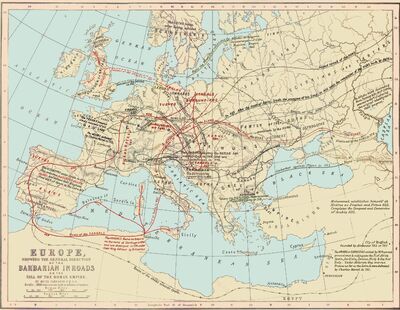| Untranslated Page | This article has not yet been translated into Anglish. Please translate it as soon as possible. |

The word Folkwandering is a betokening in yorelore-scholarship for the time when folkgroops of mainly Thedish stock spread out from their homelands in northern Europe and wandered into the Romish Rich, following the inroads of the Huns into East-Middle-Europe in the late fourth yearhundred, and ending in the late sixth yearhundred. Thus the Folkwandering-Time begins in late Oldendom and lasts until the Early Middle Eld, and is therefore thought of as a shift-time between 'classical' Oldendom and the Middle Eld.
After the death of Kaiser Theodosius ('The Great') in 395 A.D. the rich was dealt in two halves, with the western Keiser's seat at Mayland, and the eastern kaiser's seat at Constantinople (later known to the Shedlandish folks as 'Micklegarth'). In 382 and again 418 the Wisigoths (sometimes called 'Westgoths') plighted their troth with the Romish onwald, which lead to the lawful settling of Goths within the marks of the rich on the foreward that they should abide by Romish law. The Franks were also given leave to settle on Romish lands, having been hired as foederati ('troth-mates', or 'troth-geneats') to weer the mark of northern Gallrich. After the Rhine-fording of 406 and the inflood of Wendels and Sueves (forefathers of the folk of the Dutch landship of Swavenland) into the Western Romish Rich followed the slow but siker crumbling of Western Romish overlordship. Therewhile the Eastern Romish Rich held together.
Overall Timereckoning[]
Hithercomth of the Thedish Folkstocks
Thedish folks spread out of southern Sheddeny and what is now northern Dutshland, and nearby lands between the Elf and Oder streams. The first wave went westward and southward (pushing the inlandish Celts west to the Rhine by about 200 BC) and wandering into southern Dutshland up to the Romish outshire of Gallrich by 100 BC, where they were stopped by Gaius Marius and Julius Caesar. A later wave of Thedish folkstocks wandered eastward from Sheddeny between 600 and 300 AD to the other shore of the Eastsea (OE Ōst-sǣ is seemingly borrowed from an a-grade of Old Norse Eystra-salt or an unbooked *Austr-sær.).
First Timespan
The Folkwandering Time may be dealt into two timespans. The first timespan, running from 300 to 500 AD, is somewhat logged by Greekish and Latinish yorelarers but hard to make out in oldendom-finds. These writings show Thedish folks holding sway over most deals of the then-Western Romish Rich. The Wisigoths came into Romish lands (after a clash with the Huns) in 376. The following year in Marcianopolis, the body-ward to the king of Gothenrich and here-leader Fredegern was killed while meeting with Lupicinus, steadholder of Valens in Thrace. The Wisigoths rose up and wandered into Italy and sacked Rome in 410, before settling in Iberia and staddling a kingdom which lasted for 200 years. They were followed into Romish lands by the Eastgoths, led by Theedrick the Great, who settled in Italy.
In Gallrich the Franks (a mingling of western Thedish kindreds whose leaders had been bounden to Rome sints the third yearhundred AD) went into Romish lands step by step and frithly during the fifth yearhundred, and were bowed before as overlords by the Gallish-Romish lede. Weering off onslaughts from the Alemanns, Burgends and Wisigoths, the Frankish kingdom became the heart of the tocoming Frankrich and Dutchland. The beginning of the Anglesaxish settling of Briten happened in the fifth yearhundred, after Romish walding had left Briten.
Other Timespan
The other timespan took stead between 500 and 700 and saw Winnetish folkstocks settling in Middle- and Eastern Europe (besunders in eastern Magna Germania). In 567, the Avars and the Langobards fornaughted much of the rich of Gepids. The Langobards (th.i. "the long beards") a Thedish folk, settled in northern Italy in the landship now known as Lombardy. The Bulgars and Avars (a middle-asish riderfolk of Turkish or Iranish beginnings who were atwesend in far Eastern Europe sints the twoth yearhundred) overwon the eastern Balkan-lands of the Byzantinish Rich in the seventh yearhundred.
Amidst the early Byzantinish-Arabish-orlaw the Arabish heres sought to come into Southeast-Europe by way of Little Asia in the late seventh and early eighth yearhundreds, but were overcome at the besetting of Constaninople by the meansome strithe-mights of Byzantium and the Bulgars. During the Kazarish-Arabish orlaws, the Khazars stopped the Arabish Outspreading into Eastern Europe over the Caucasus. At the same time, the Moors (made up of Arabs and Berbers) inthrang Europe by way of Erkel's Syles—the Iberish Half-iland—from the Wisigothish Kingdom in 711), before being held up by the Franks at the Slaught of Tours in 732. These battles greatly settled the edge of the mark between Christendom and Mussulmandom for the next yearthousand. The following yearhundreds saw the Mussulmen syefast in winning Sicily from the Christens.
Weather-Umstandnesses[]
Some writings from the time speak of a spell of harsh weather in the years 535 and 536. Tokens bearing witness to this cold time are also found in tree-ring-timereckoning and ice-kernels. The orsakes and outcomes of this cold time are wrangled over.
Thedish Folks[]
Goths and Wendels
The Wisigothenrich (otherwise "Westgothish Rich") was groundwrought in 418 when the Romish Rich lost its sway outside of Italy, and lasted until 721 (having been bound until 471 with the Western Romish Rich)
At its greatest girth the rich infathomed the Iberish half-iland, inholding Gallaecia, the Northwest of Hispania Lusitania (where the Suevish Rich had been), the north-coast of Spaneland (here dwelt the Cantabriers and Basks), and a great deal of Frankrich, roughly Occitania and the land south of the Leyer .
Angles, Saxen, Yoots, and Freeses